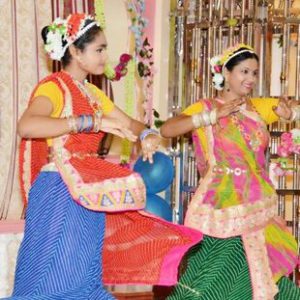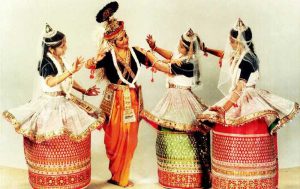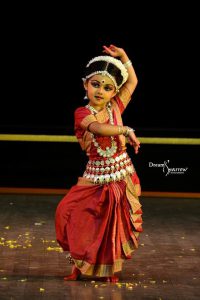I have always had a thing for dancing and when was a little girl my mom got me into dancing, not ballet but a classical Indian dancing called Kathak. Now you might be wondering what in the world is that well let’s dive into it.
Kathak
Kathak is one of the main genres of ancient Indian classical dance and is traditionally regarded to have originated from the travelling bards of North India referred as Kathakars or storytellers. Like the early Greek theatre, these Kathakars roamed around telling legends with music, dance, and songs. The Bhakti movement, a trend of theistic devotion that emerged in medieval Hinduism, gave birth to the genre.
The only reason I got into Kathak dancing is because my mom herself was and still is a professional Kathak dancer (yes, she’s old but gold).

There is me (on the left) and my mom (on the right) performing at a local event in 2018.
My mom and I have performed many times in different places around Guyana.
However, Kathak is not the only Classical Indian Dance form there is in fact it isn’t even the most popular one! There are eight Indian Classical Dances including Kathak which are:
Bharatanatyam
Bharatanatyam is one of the oldest of all the contemporary classical dance styles, and it continues to play an important role in our culture. Over the years, ingenuity and creativity have shaped it into a spiritual, divine, and significant addition to our society without compromising its basic purpose and core. Bharatanatyam, or classical dance as a whole, is a science in and of itself, with plenty of potential for improvisation and inventive interpretations. To maintain its originality and purpose, one must adhere to the parampara, shastras, sampradaya, and a set of technical standards. It is also the most well-known classical Indian dance worldwide. The picture below displays a some Bharatnatyam dancers during a performance of an old Indian tale.

Mohiniyattam
Mohiniyattam as we know it today is the result of a protracted evolutionary process. Its origins can be traced back to Kerala’s temples. Though the exact date of its inception is unknown, there is evidence to support the existence of a group of female temple dancers who aided temple rites by adding expressive movements to the mantras repeated by temple priests. During different periods of time, the dancers were given different names. This ancient art form is characterized with unhurried motions, a wavering yet graceful symphony of hips and eye movements that mesmerize those who observe it. Kerala’s culture is known with its exquisite costumes, traditional jewelry, and enticing make-up. The picture below shows a performer doing Mohiniyattam.

Kathakali
The storytelling style of this art is Kathakali, an important genre in Indian classical dance. It’s a dance drama from Kerala, India’s southernmost state. The story in ‘Kathakali’ is also transmitted to the audience through great footwork and impressive facial and hand gestures, accompanied by music and vocal performance, similar to other Indian classical dance arts. The detailed and vibrant make-up, unique face masks, and costumes worn by dancers, as well as their style and motions, which represent the age-old martial arts and athletic norms widespread in Kerala and adjacent regions, set it apart from the others. Traditionally performed by male dancers, it arose in Hindu areas’ courts and theaters, as opposed to other Indian classical dances, which arose primarily in Hindu temples and monastic schools.
Pesonally, this dance form is the most expressive to me and VERY interesting I love watching the perfomances! I mean just look at the picture below.

Kuchipudi
Kuchipudi, a representative form of Indian classical dance and one of India’s top ten classical dances, is a dance theater art that originated in a village in Krishna, Andhra Pradesh, India. Like all major forms of classical Indian dance, Kuchipudi has its roots in the ancient Hindu Sanskrit texts of Natya Shastra and has evolved into a religious art traditionally associated with temples, spiritual beliefs, and itinerant minstrels.

Manipuri
The Manipuri dance is considered one of the main classical dance forms in India, with especially themes based on Vaishnavism and spectacular performances by Ras Lila, and a dance drama based on the love between Radha and Krishna. Other themes included in this art form relate to Shaktism, Shaivism, and the forest god Umang Lai during the Lai Kharaoba manipuri festival. This dance form is named after the state of Manipur in northeastern India where it originated, but has its roots in Natya Shastra, an old Sanskrit Hindu text. You can feel the mixture of Indian and Southeast Asian cultures. The ancient dance traditions here are reflected in the great Indian epics “The Ramayana” and “The Mahabharata”, where the Manipur dancers are called “Gandharva”. Manipuri performs this religious art that seeks to express spiritual values during Hindu festivals and other important cultural events such as weddings. As seen from the picture below they have really interesting clothing!

Odissi
Odissi is a classical dance that originated in Odisha, India. Odissi, also known as Orissi in ancient literature, is a major classical dance of ancient India that originated in the Hindu temples of Odisha, a coastal country in eastern India. Odissi, in her story, is mainly played by women and presents religious stories and spiritual ideas, especially of Vaishnavism (Vishnu as Jagannath). Odissi’s performance also embodies ideas about other traditions such as those associated with the Hindu gods Shiva and Surya, as well as the Hindu goddesses. Modern Odissi is performed by children and adults, solo or in groups. As a kid this was the first indian classical dance I was taught and let me tell you it is much harder than it looks.
Here is even a video you can watch: Maryam Shakiba – Odissi Dance – Manglacharan Ganesh Vandana – YouTube

Sattriya
The Sattriya dance form was introduced in the 15th century AD by the great saint Vaishnava as a powerful means of spreading faith. The dance form evolved and was subsequently developed as a particular dance style. This treasure of Assamese Neo-Vaishnava dance and theater has, over the centuries, been nurtured and preserved with great commitment by the Sattras, i.e. mathematic or Vaishnava monasteries. Due to its religious character and its association with the Sattras, this dance style is aptly named Sattriya. Sankaradeva introduced this dance form by combining different elements from different treatises, local folk dances with her own rare perspective.

Whew, that was a lot of information but now you know more! I’m glad I could share this part of my life with you guys. Since we’re on the topic of dance you can maj0r in dancing at CCBC and/or be part of the dance clubs on your campus.
Take care and stay smart but still fun 🙂




